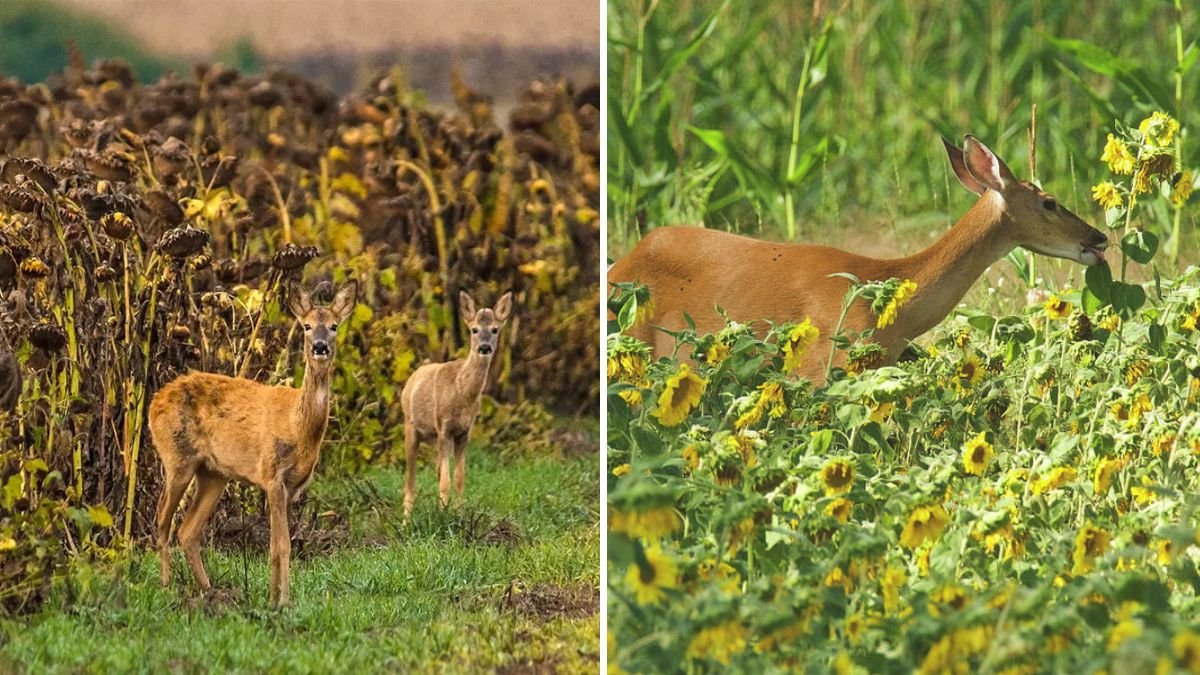Sunflowers are among the most cheerful and iconic flowers in any garden. Their bright yellow blooms and tall stalks make them a favorite among gardeners and photographers alike. However, in many regions, deer pose a significant threat to sunflower beds. These graceful creatures are herbivorous and opportunistic feeders, often finding tender sunflower shoots and blossoms irresistible.
While fencing and chemical repellents can be effective, many gardeners prefer natural, eco-friendly ways to protect their sunflowers. This guide explores proven strategies for keeping deer away, promoting healthy blooms, and maintaining a thriving garden without harming wildlife.
1. Understanding Deer Behavior
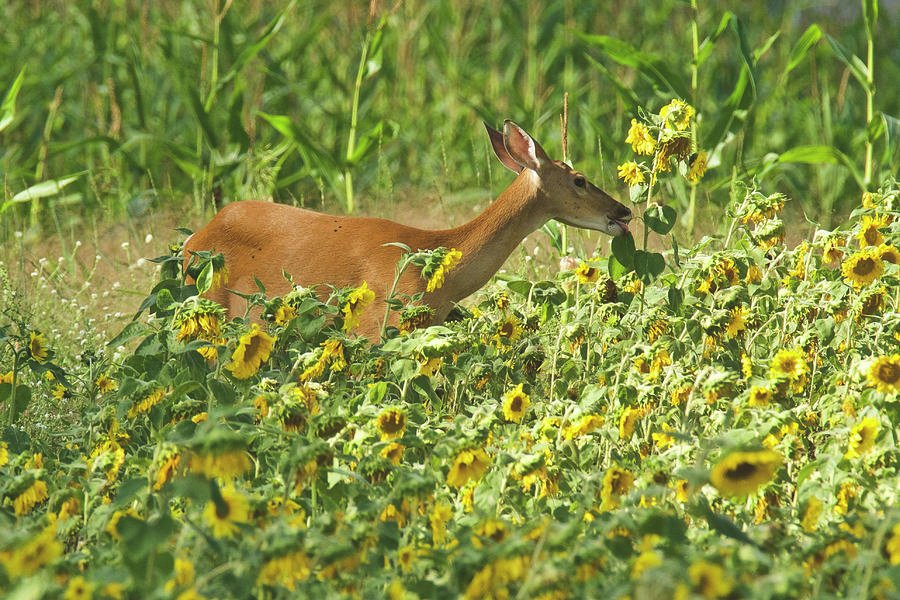
Before implementing protective strategies, it’s important to understand why deer are attracted to sunflowers:
- Tender shoots: Young sunflower sprouts and buds are particularly palatable.
- High nutrient content: Sunflowers provide calories and nutrients that deer need, especially in early spring.
- Easy access: Gardens without barriers or deer deterrents are prime feeding grounds.
Pro Tip: Deer are creature-of-habit animals. Once they discover a food source, they will repeatedly return, making early prevention critical.
2. Natural Fencing Solutions
One of the most effective ways to keep deer away is creating a physical barrier without resorting to chemicals:
Options for Natural Fencing
- Tall garden fencing: Deer can jump over low barriers. Fences should be at least 8 feet high.
- Hedge barriers: Plant thorny or dense shrubs around sunflower beds, such as holly, barberry, or hawthorn.
- Temporary stakes with netting: Lightweight garden netting or mesh can be erected around young sunflowers until they are more established.
Pro Tip: Combining multiple fencing strategies, like a hedge with netting, increases effectiveness.
3. Deer-Repelling Plants
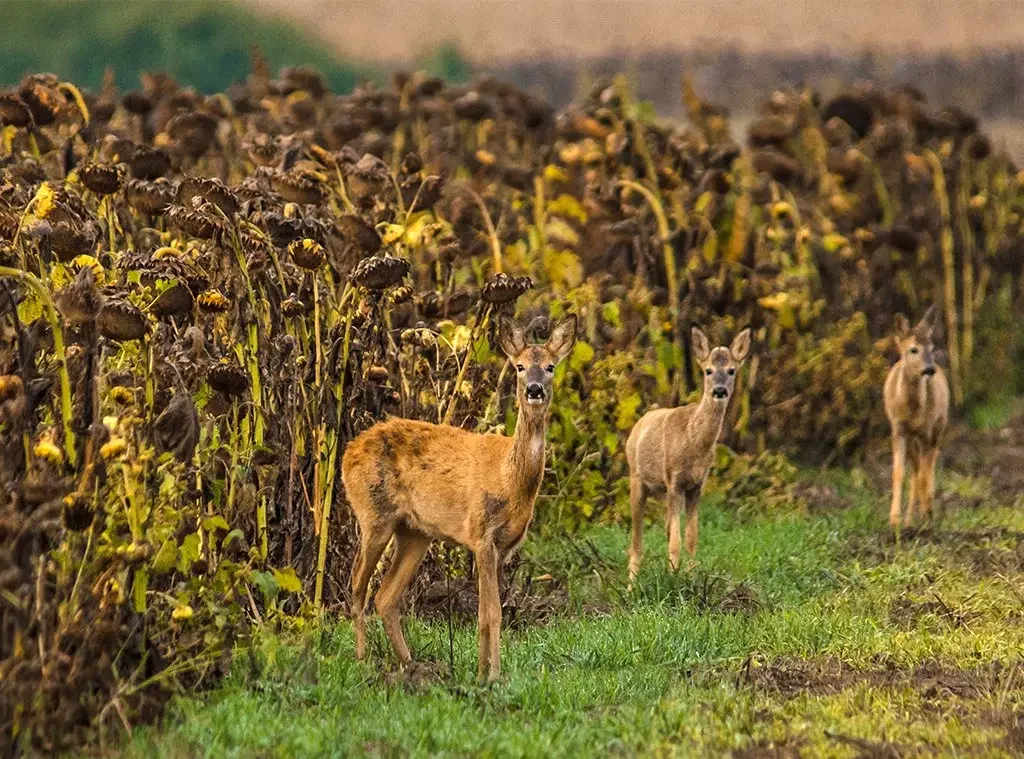
Gardening enthusiasts often use companion plants to naturally deter deer:
- Strong-smelling herbs: Lavender, rosemary, sage, and mint are disliked by deer.
- Alliums: Ornamental onions, garlic, and chives create a smell barrier.
- Spicy flowers: Marigolds, zinnias, and certain salvias can reduce deer visits.
Planting these around or interspersed with sunflowers not only protects them but also enhances visual appeal.
Pro Tip: Grouping several deterrent plants together creates a more potent smell barrier for deer.
4. Homemade Deer Repellents
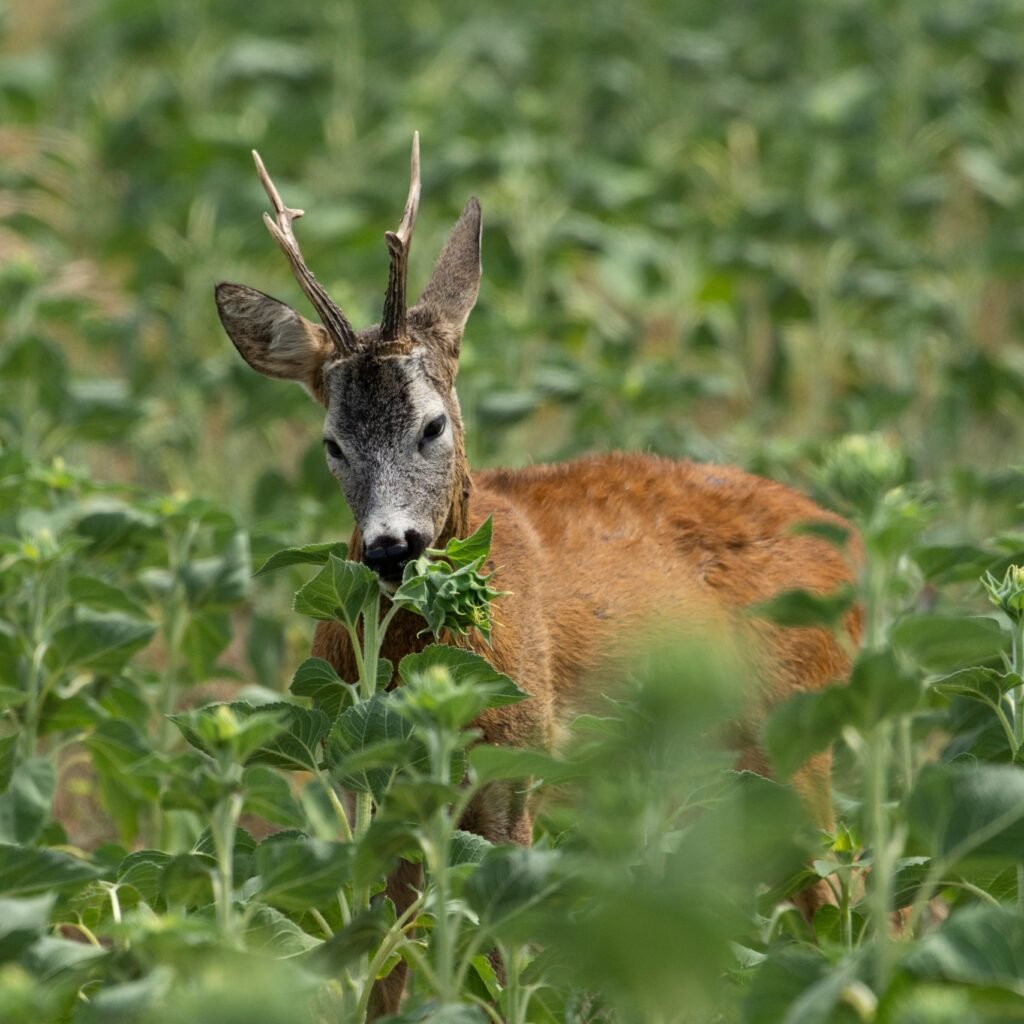
Sprays made from natural ingredients can be applied to sunflower leaves and stems:
Common Natural Repellents
- Garlic or onion spray: Blend cloves with water and a small amount of soap; spray on foliage.
- Hot pepper spray: Mix chili powder or hot sauce with water and a few drops of dish soap.
- Egg-based spray: Mix eggs with water to create a protein-based deterrent.
- Soap bars: Hang strong-smelling soaps around sunflower beds; deer dislike the odor.
Application Tips
- Apply in the early morning or late evening for best absorption.
- Reapply after rain or heavy watering.
- Rotate sprays to prevent deer from getting used to a single scent.
Pro Tip: Natural repellents are most effective in combination with other protective strategies.
5. Strategic Garden Placement
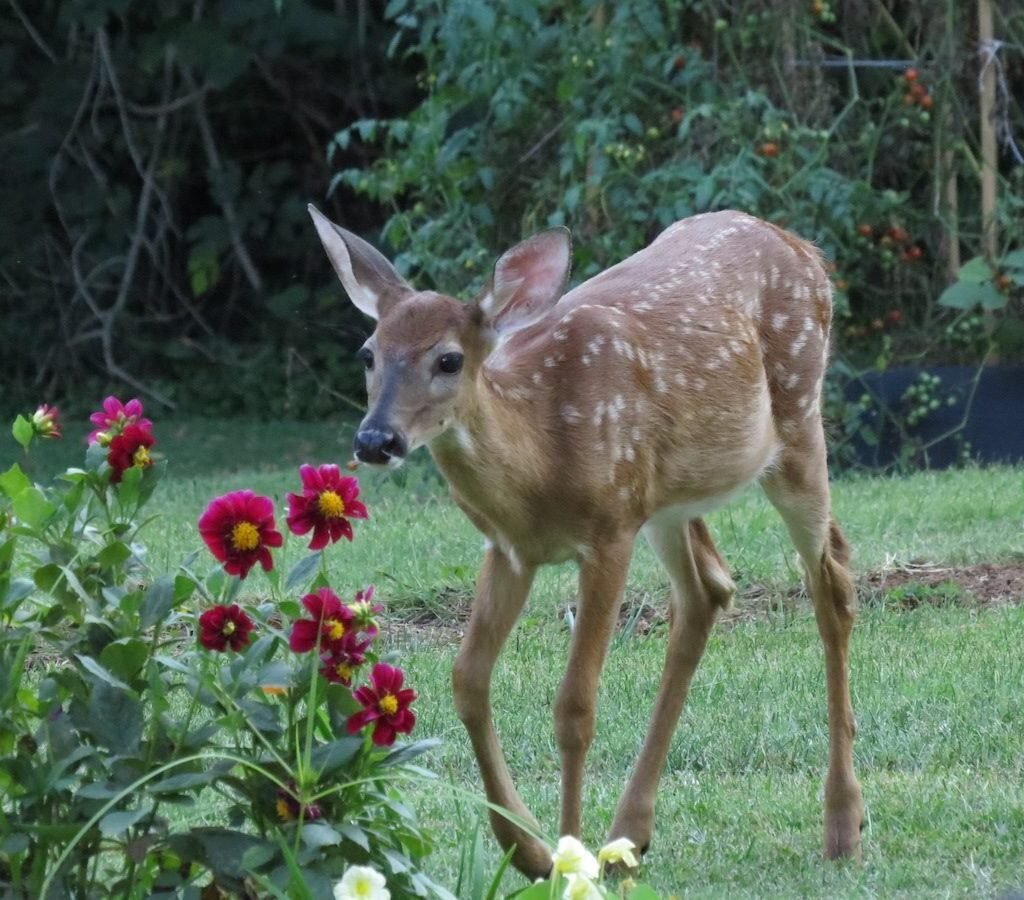
Where you plant sunflowers can influence deer activity:
- Raised beds: Elevating sunflower roots makes them harder to reach.
- Away from edges: Plant sunflowers toward the center of the garden rather than near paths or wooded areas.
- Dense plantings: Interplanting sunflowers with deterrent plants can reduce visibility and accessibility.
Pro Tip: A central garden bed surrounded by herbs and shrubs forms a natural protective barrier for your sunflowers.
6. Timing Plantings
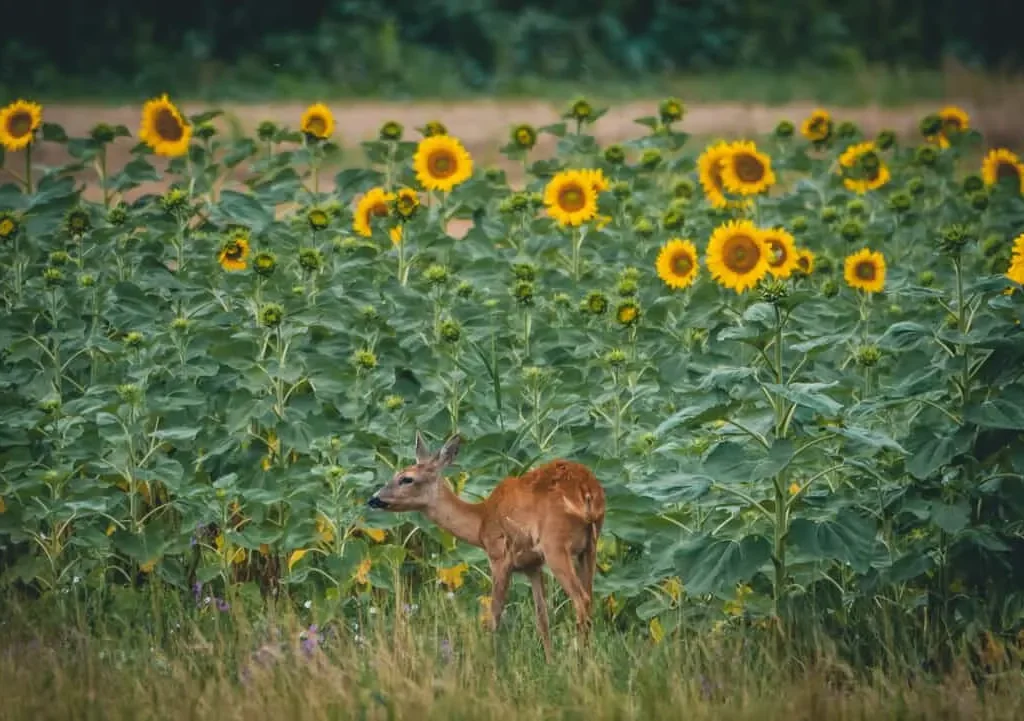
Adjusting the timing of your sunflower plantings can reduce deer damage:
- Plant in late spring: Early emergent shoots attract hungry deer; slightly later planting may avoid peak deer feeding periods.
- Succession planting: Staggering planting times ensures that some flowers bloom when deer pressure is lower.
Pro Tip: Early-season protection is crucial since young, tender shoots are the most vulnerable.
7. Encourage Natural Predators
Creating a garden environment that encourages deer predators can help reduce visits:
- Dogs or cats: Supervised pets can act as deterrents without harming deer.
- Birds of prey: Hawks and owls in the area naturally discourage deer.
- Scare devices: Motion-activated lights or noise-makers simulate predator presence.
Pro Tip: Predators are most effective when used alongside fencing and repellents, creating a multi-layered defense system.
8. Habitat Modification
Deer are more likely to invade gardens that provide cover and easy access. Reduce risk by:
- Clearing brush: Remove tall grass, weeds, or piles of debris near sunflower beds.
- Pruning nearby shrubs: Open up sightlines to make the garden less inviting.
- Removing attractants: Avoid feeding pets outdoors or leaving compost piles exposed.
Pro Tip: A tidy, well-maintained garden discourages deer from making it a habitual feeding spot.
9. Combining Strategies for Maximum Protection
Deer are persistent, so relying on a single method rarely works. Experienced gardeners recommend a layered approach:
- Physical barriers: Fences, netting, or thorny hedges.
- Repelling plants: Strong-smelling herbs and alliums around sunflower beds.
- Natural sprays: Rotate garlic, chili, or egg sprays.
- Garden placement: Raised beds, central planting, and dense borders.
- Habitat management: Remove hiding spots and attractants.
Pro Tip: Early intervention and consistency are key—start protection before sunflowers emerge.
10. Benefits of Natural Deer Control
Using natural methods offers several advantages:
- Eco-friendly: Protects wildlife without chemicals.
- Safe for children and pets: Avoids toxic sprays.
- Cost-effective: Homemade repellents and strategic planting reduce expenses.
- Long-term sustainability: Encourages balanced ecosystems in your garden.
Pro Tip: Natural solutions can be combined with seasonal monitoring to maintain deer-free sunflower beds year after year.
Final Thoughts
Sunflowers are worth every effort to protect. By understanding deer behavior and using a combination of fencing, deterrent plants, natural repellents, strategic placement, and habitat management, gardeners can enjoy vibrant, healthy sunflowers without conflict.
Key takeaways:
- Start protection early, before shoots emerge.
- Use a multi-layered approach combining barriers, repellents, and companion plants.
- Manage your garden environment to make it less appealing to deer.
- Maintain consistency and monitor for signs of deer activity.
With patience and thoughtful planning, your sunflower beds can thrive all season, providing sunny blooms, attracting pollinators, and remaining free from deer damage. Your garden becomes not only a haven for sunflowers but also a showcase of sustainable, wildlife-conscious gardening.
